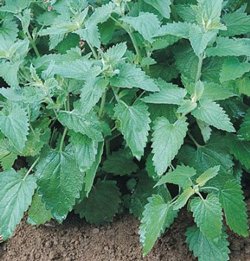Catnip Tea
Catnip tea is an excellent, all-natural way to relax, ease tummy troubles and even fight off a cold or flu. No self-reliant homestead should be without this helpful herbal tea.

So what exactly is catnip? It's a perennial herb that is also
herbaceous, meaning it is a plant with non-woody stems. This herb can be
found out in the wild in parts of North America and can also be easily
grown in a garden bed.
It earned its name from the euphoric
effect it can have on cats. Kitties love the smell and can sometimes get
a natural high from smelling catnip, although not all cats are
susceptible to the high.
Catnip versus Catmint
While the names "catnip" and "catmint" are sometimes used interchangeably, they are actually two different plants, although both are related.
The botanical name for catnip is Nepeta Mussinii, while catmint is called Nepeta Cataria. Ironically, cats are more attracted to catmint than they are to catnip.
The Benefits of Catnip Tea
There are a number of great benefits that come from drinking catnip tea, including some of the following:
Helps You Sleep
Are you feeling too restless to sleep? A natural chemical in catnip - nepetalactone - promotes relaxation and helps you sleep.
Natural Pain Relief
Catnip can also relieve pain due to menstrual cramping. Suffering from a migraine? Catnip can help reduce the pain.
Recover From Colds More Quickly
Drinking an infusion of catnip will promote perspiration without raising your core body temperature, making it an excellent remedy when you are suffering from a cold or flu as it will draw out the toxins from your body.
Drink It for Colic
Because it is a safe, gentle remedy for flatulence and gas pain, an infusion of catnip is a great natural remedy for infants and toddlers. Add some stevia leaves to the catnip infusion for a mildly sweet, tasty tea.
How to Make Catnip Tea
For an infusion of catnip, place one teaspoon of dried catnip or three to four teaspoons of fresh catnip leaves in a tea ball or just place the leaves directly in the bottom of a cup. Bring water to a boil and allow it to cool slightly. Don't boil the leaves or it will render the healing chemicals in catnip ineffective.
Pour the hot water over the leaves and allow them to steep for about ten minutes. If you are not using a tea ball, pour the liquid through a strainer to remove the leaves. Add raw honey, lemon juice or sugar.
Growing Catnip
Catnip can grow easily in almost any kind of soil. Because this herb enjoys full sun and is drought-tolerant, it is excellent for sunny, dry areas.
Plant catnip by sowing the seeds in rows about 20 inches apart. Once the seedlings appear, thin them to about one to two feed apart in each row, as the plants become quite large and will readily take over.
Harvesting Catnip
Cut the stalks of catnip and hang them to dry in a dark, cool area. Once the leaves have completely dried, remove the leaves from the stems and store the leaves in a plastic bag. Store your catnip in a cool, dark place.
Learn More About Medicinal Herbs
Return from Catnip Tea to the Home Page








New! Comments
Have your say about what you just read! Leave me a comment in the box below.